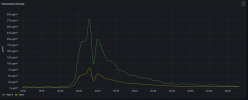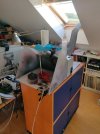michael080
Western Thunderer
good morning,
I am living close to Stuttgart in Germany and everybody who has been there knows that it is located in a deep valey. It has always been a town with a lot of air pollution problems. Years ago the town administration set up local measurement stations to determine the air quality. The values were so concerning that traffic was restricted in some days in winter times. People were concerned and started to wonder what impact that would have on their living in the town. To gather more information, a group started to develop cheap measurement devices that could be setup for some 30€ and that allowed to analyse the airborne particle load in the 2.5µm and 5µm size range. This project is still very active and I have build a couple of these devices in the last years. If you want to see how the results look, visit
https://maps.sensor.community
Yesterday eveneing, I painted some parts from my BR70 project while one of these sensors was sitting on my bench for testing.
here is what the particle counter detected.

The background load of these counters is at about 5µg/m³ for the smaller 2.5µm particles and peaks up to almost 300µg/m³ immediately.
The EU limit for this size of dust is 50µg\m³. 2.5µm particles are respirable!
It opened the windows right after spraying, so the values come down again quite quickly, but this is a large 25 sqm room under the roof wiht a high ceiling and it was a small paint job.
I am using a fume extraction cabinet that are sold at ebay cheaply and I am using a simple FP3 mask while spraying, but this is a worrying result.
My conclusion is that I will use my tightly sitting Draeger respiratory mask with P3 filters from now on even for spray jobs using acrylic paint.
On the positive side, good to see that my air brush atomization is working very well.
Michael
I am living close to Stuttgart in Germany and everybody who has been there knows that it is located in a deep valey. It has always been a town with a lot of air pollution problems. Years ago the town administration set up local measurement stations to determine the air quality. The values were so concerning that traffic was restricted in some days in winter times. People were concerned and started to wonder what impact that would have on their living in the town. To gather more information, a group started to develop cheap measurement devices that could be setup for some 30€ and that allowed to analyse the airborne particle load in the 2.5µm and 5µm size range. This project is still very active and I have build a couple of these devices in the last years. If you want to see how the results look, visit
https://maps.sensor.community
Yesterday eveneing, I painted some parts from my BR70 project while one of these sensors was sitting on my bench for testing.
here is what the particle counter detected.

The background load of these counters is at about 5µg/m³ for the smaller 2.5µm particles and peaks up to almost 300µg/m³ immediately.
The EU limit for this size of dust is 50µg\m³. 2.5µm particles are respirable!
It opened the windows right after spraying, so the values come down again quite quickly, but this is a large 25 sqm room under the roof wiht a high ceiling and it was a small paint job.
I am using a fume extraction cabinet that are sold at ebay cheaply and I am using a simple FP3 mask while spraying, but this is a worrying result.
My conclusion is that I will use my tightly sitting Draeger respiratory mask with P3 filters from now on even for spray jobs using acrylic paint.
On the positive side, good to see that my air brush atomization is working very well.

Michael
Last edited:



 We used to collect it out of tilt switches at BT, scoop it up with a sheet of paper or prod it with your fingers into the jar.
We used to collect it out of tilt switches at BT, scoop it up with a sheet of paper or prod it with your fingers into the jar.